|
Charaxes marmax (WESTWOOD) - îgß潺 - Yellow Rajah
| Indroduction | The Butterfly | Courtship and Mating | Ovipositing behaviour and mortality | Food plant | Voltinism | Immature stages | Table for Comparison | Acknowledgment | Reference | Plates |
Reprint from FUTAO No.34 Entomological reports of FUTAO-KAI
C/O Hiroto HANAFUSA - 688-2, Tashima, Tottori-shi, Tottori, 680-0804 JAPAN / September 1, 2000
A brief note on the life history of Charaxes marmax WESTWOOD and a comparison with Charaxes bernardus (FABRICIUS) Lepidoptera, Nymhalidae in Hong Kong, PRC
James J. YOUNG - 20/F Tung Wai Comm. Bldg., 109-111 Gloucester Road, Wanchai, Hong Kong, P.R.C.
Abstract
A brief summary of the life history of Charaxes marmax WESTWOOD (Nymhalidae: subfamily-Charaxinae) is described and its various aspects are compared in table form with its sister species Charaxes bernardus (FABRICIUS) in Hong Kong.
Key Words
Nymphalidae, Charaxes marmax, life history, comparison, Charaxes bernardus, Hong Kong.
Introduction
So far there are only two Charaxes species recorded in Hong Kong. Charaxes marmax seems to be a newcomer to Hong Kong and is only recorded in the last 10 years. Charaxes marmax has a more northern distribution than Charaxes bernardus, ranging from north India, Burma, and Thailand to south China. (BASCOMBE 1999)
The Butterfly
Charaxes marmax is a large Nymphalid. It is pale brown-orange in colour and closely resembles its sister species, C. bernardus. However, the black marking on C. marmax is much reduced and is more reddish than C. bernardus which is very variable in wing pattern over in its entire range. The two sexes are dimorphic and vary greatly. The female is comparatively larger in size and is tailed. There appears to have no seasonal forms.
It has a fast and robust flight. It does not fly low except when feeding. It tends to settle high up on treetops, on the upper side of leaves with its folded wings. It does not visit flowers but feeds readily on tree saps and rotten fruits. The butterfly does not drink at mud puddles.
The male butterflies exhibit strong territorial marking, and unlike C. bernardus, they show hill topping behaviour. They will patrol a certain area and investigate any intruding butterflies and return to the same twig or leaf. Often time they dart off from perching treetop to investigate the aliens, attempt to mate if they are females, or if taken as intruders, proceed to harass and chase until they retreat out of their domain.
The butterfly is very localised and is only found in a number of places in the New Territories and on Lantau Island. It is fond of hill topping at Kun Yam Shan and Cloudy Hill in Tai Po and Ngau Ngak Shan in Ma On Shan.
This paper presents the result of the rearing of the butterfly from a single egg collected in April at Lo Han Temple, Tung Chung, under indoor controlled conditions.
Courtship and Mating
No courtship behaviour has been observed. Presumably, the male will chase the female around before mating occur. It seems that mating will take place down in the valley, as mating has never been observed at hilltops.
Ovipositing Behaviour
No ovipositing behaviour is observed. It appears that the female will fly down and settle on its host plant, touch the leaf with its abdomen and lay her egg. Not more than one egg has been found on a single piece of leaf. Generally this is accomplished in a couple of seconds, just like its sister species Charaxes bernardus. (See photograph 16)
Food plant
The host plant is Croton tiglium L. (Euphorbiaceae). A small tree with green milky sap found throughout Hong Kong. (HO, 1981)
Voltinism
The butterfly is multivoltine. The butterfly will appear in the middle of April and disappear in late December. It seems to overwinter in the final instar larval stage or as pupa.
Immature stages
Egg: The egg is yellow in colour when freshly laid, turning brownish before the larva emerges from its eggshell. It shapes like a barrel, flattened on top and curved towards the bottom. It measures about 1.4 mm in height and 1.6mm in diameters. The caterpillar will emerge in about 4 days.
Larva: The 1st instar is pale green in colour, the brownish forehead with 2 pairs of horns are typical of the Charaxes and Polyura species. The emerging larva will consume part of its eggshell and the 1st instar stage lasts about a week. The larva is solitary and rests on a tiny silk pad spun on top of a leaf. It tends to stay with the leaf and does not wander far to feed. It measures from 4mm to 6mm.
The 2nd to 4th instar lasts about 19 days. It becomes much greener and the V shaped anal projection becomes much broader and shortens when it grows older. It measures from 6 mm to 3.5 cm. The larva bears no superficial difference from that of C. bernardus, apart from the slightly more blackish horns and less profound air spiracles on the side of the abdomen.
The 5th or final instar lasts for 10 days before pupation. It measures up to 6cm for the female. The larva will pupate and attach itself on a leaf stalk. The pupa is green with some splashes of white on the surface. It is smooth and shaped like a bulging banana, though a bit short and rounded. It measures about 2.4 cm for the female, which is generally slightly longer in length.
When it is time to emerge, the entire colour form of the butterfly will show through the pupal case. It will then emerge within the next 24 hours, usually in the twilight hours of the morning. The pupal stage lasts about 21 days. The 1st brood over-wintering in pupal stage takes much longer. The whole duration from egg to adult takes approximately 61 days to complete.
Table for Comparison**
|
ADULT |
Charaxes marmax WESTWOOD |
Charaxes bernardus (FABRICIUS) |
|
GENERAL |
|
|
|
Size, Shape, Pattern |
Comparatively larger; more reddish but black markings much reduced |
Slightly smaller; more brownish with black markings |
|
Polymorphic with distinguishable forms |
Sexual dimorphic only but no other distinguishable forms |
Sexual dimorphic and has 2 forms:form sinensis and form bernardus |
BEHAVIOUR HABITS |
|
|
|
Feeding on flowers |
No |
No |
|
Feeding on tree saps and rotten fruits etc. |
Yes |
Yes |
|
Drinking at puddles |
No but prefer animal urine |
No but prefer animal urine |
|
Territorial Marking–Patrolling Perching |
Yes |
Yes |
|
Hill topping |
Yes |
No |
|
Flight period |
April to December |
March to December |
|
Voltinism |
Multiple |
Multiple |
|
LOCATION & STATUS |
|
|
|
Location sighted |
Rare and localised - Kun Yam Shan, Cloudy Hill, Fung Yuen, Ngau Ngak Shan, Shek Mun Kap and San Tau on Lantau Island |
Common - throughout Hong Kong |
|
IMMATURE STAGES |
|
|
|
Host plant |
Croton tiglium L. (Euphorbiaceae) |
Cinnamomum camphora (Lauraceae) and Acronychia pedunculata (Rutaceae) |
|
Egg laying |
Top of leaf |
Top of leaf |
|
Egg |
Barrel shape yellow when freshly laid;
Duration - 4 days |
Barrel shape yellow when freshly laid;
Duration - 3 days |
|
1st instar larva |
Eat its shell as first meal -no particular superficial difference;
Duration - 7 days |
Eat its shell as first meal - no particular superficial difference;
Duration - 6 days |
|
2nd to 5th instar larva |
Stay on top of leaf with silk pad spun upon leaf - no particular superficial difference except slightly blackish horns and less profound air spiracles on side of abdomen;
Duration - 29 days |
Stay on top of leaf with silk pad spun upon leaf - no particular superficial difference except more reddish horns and more profound air spiracles on side of abdomen;
Duration - 28 days |
|
Pupa |
Smooth greenish like bulging banana - no particular superficial difference;
Duration - 21 days |
Smooth greenish like bulging banana - no particular superficial difference ;Duration - 12 days |
|
Duration from egg to adult |
61 days |
49 days |
** N.B. comparison for immature stages is based on rearing data for the months April to June
Acknowledgment
I thank Dr. David Tang for reviewing my paper and the staff at the Hong Kong Herbarium for identifying the host plant.
Reference
BASCOMBE M.J., JOHNSTON G. BASCOMBE F.S., 1999 The Butterflies of Hong Kong, Academic Press, London, UK.
HO M. H. 1980 Hong Kong Poisonous Plants, Urban Council, Hong Kong
Plates
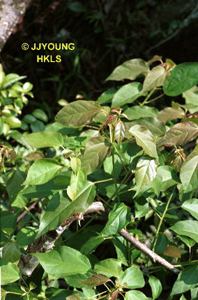
|
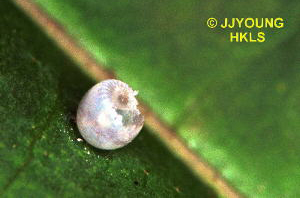
|
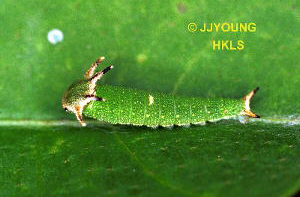
|
1, Host plant - Croton tiglium L. (Euphorbiaceae) |
2, Empty egg shell |
3, 2nd instar larva |
|
|
|
|
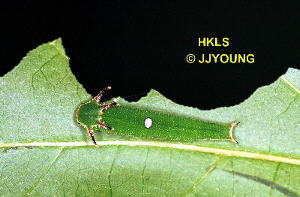
|

|

|
4, 3rd instar larva |
5, 4th instar larva |
6, 5th or final instar ?top view |
|
|
|
|
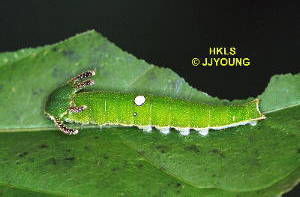
|
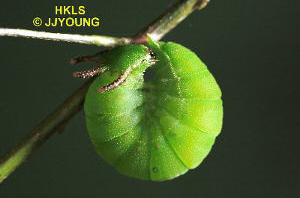
|
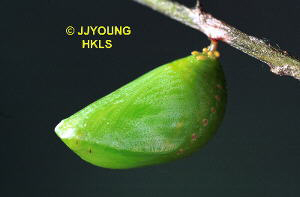 |
|
7, 5th or final instar ?side view |
8, 5th or final instar prior pupating |
9, Pupa ?side view |
|
|
|
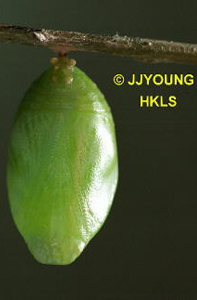
|

|
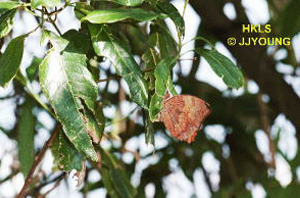
|
|
10, Pupa ?front view |
11, Male at perching posture, hilltopping at Ngau Ngak Shan , 27/6/98 |
12, Female of Charaxes bernardus laying egg on Acronychia pedunculata (Rutaceae) 26/11/99 Black's Link, The Peak |
|
|
|
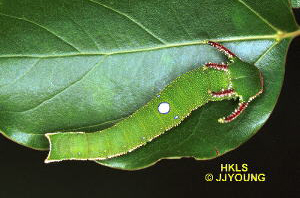
|

|
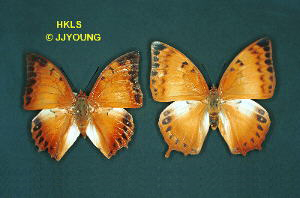
|
13, 5th or final instar of Charaxes bernardus on Cinnamomum camphora (Lauraceae) |
14, 5th or final instar of Charaxes bernardus on Acronychia pedunculata (Rutaceae) |
15, Male and female - upperside |
|
|
|

|
|
|
16, Male and female - underside |
|
|
(Prepared by J.J. Young)
This page was created on 6th December, 2000.
©2004 Hong Kong Lepidopterists' Society Limited
|